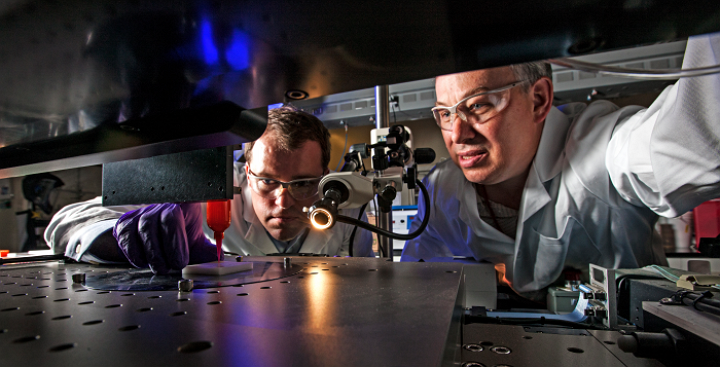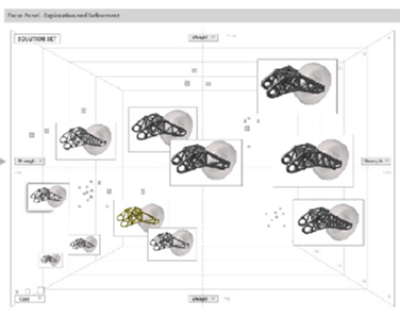 Teams of researchers from Lawrence Livermore National Laboratory (LLNL) and Autodesk have signed an agreement which will see them begin work on exploring ways design software can be used to accelerate innovation for 3D printing of advanced materials.
Teams of researchers from Lawrence Livermore National Laboratory (LLNL) and Autodesk have signed an agreement which will see them begin work on exploring ways design software can be used to accelerate innovation for 3D printing of advanced materials.
The 18-month-long Cooperative Research and Development Agreement (CRADA) means the LLNL team will use software for generative design from Autodesk Inc. to study material microstructures.
 This project will use key technologies such as additive manufacturing, material modeling and architected design which will arrange materials at the micro- and nanoscale levels through computational design.
This project will use key technologies such as additive manufacturing, material modeling and architected design which will arrange materials at the micro- and nanoscale levels through computational design.
The LLNL and Autodesk project will study ideas for next-generation protective helmets as a test case for the collaboration to examine ways to improve design performance, and as helmets represent objects which require lightweight structure and must absorb impact and dissipate energy predictably, they say the project is ideal for studying advanced additive manufacturing techniques.
The LLNL and Autodesk teams will be tasked with creating complex material microstructures capable of dissipating energy more effectively than current manufactured helmet pads made with foams and pads.
“As an organization that is pushing the limits on generative design and high-performance computing, Autodesk is an ideal collaborator as we investigate next-generation manufacturing,” said Anantha Krishnan, the associate director for engineering at LLNL.
Mark Davis, the senior director of design research at Autodesk, says focusing on helmets will provide an excellent example of a design problem with multiple objectives.
“The difference in the design method we are proposing versus historically is that many of the previous manufacturing constraints can be eliminated,” says Eric Duoss, a materials engineer and the co-principal investigator for the LLNL team with computational engineer Dan White. “Additive manufacturing provides the opportunity for unprecedented breakthroughs in new structures and new material properties for a wide range of applications.”
While the kinds of helmets to be created have yet to be determined, Duoss thinks football, baseball, biking and skiing versions are likely candidates.
“One of the important things we hope to gain from this CRADA is to know what a great helmet design looks like, and we aim to build and test components of those helmet designs,” he said.
Over the course of the last couple of years, the LLNL Additive Manufacturing Initiative team has used 3D printing to produce novel ultralight and ultrastiff mechanical materials, mechanical energy absorbing materials and printed graphene aerogels.
The LLNL team will also include computational engineers Nathan Barton, Mark Messner and Todd Weisgraber; chemical engineer Tom Wilson; materials engineer Tim Ford; chemist Jeremy Lenhardt; applied physicist Willy Moss; and mechanical engineer Michael King.
What do you think about this deal between Lawrence Livermore National Laboratory and Autodesk Research to study materials and AM techniques for manufacturing helmets? Let us know in the LLNL and Autodesk Research forum thread on 3DPB.com.
Subscribe to Our Email Newsletter
Stay up-to-date on all the latest news from the 3D printing industry and receive information and offers from third party vendors.
You May Also Like
Precision at the Microscale: UK Researchers Advance Medical Devices with BMF’s 3D Printing Tech
University of Nottingham researchers are using Boston Micro Fabrication‘s (BMF) 3D printing technology to develop medical devices that improve compatibility with human tissue. Funded by a UK grant, this project...
3D Printing Webinar and Event Roundup: April 21, 2024
It’s another busy week of webinars and events, starting with Hannover Messe in Germany and continuing with Metalcasting Congress, Chinaplas, TechBlick’s Innovation Festival, and more. Stratasys continues its advanced training...
3D Printing Webinar and Event Roundup: March 17, 2024
It’s another busy week of webinars and events, including SALMED 2024 and AM Forum in Berlin. Stratasys continues its in-person training and is offering two webinars, ASTM is holding a...
3D Printed Micro Antenna is 15% Smaller and 6X Lighter
Horizon Microtechnologies has achieved success in creating a high-frequency D-Band horn antenna through micro 3D printing. However, this achievement did not rely solely on 3D printing; it involved a combination...





























